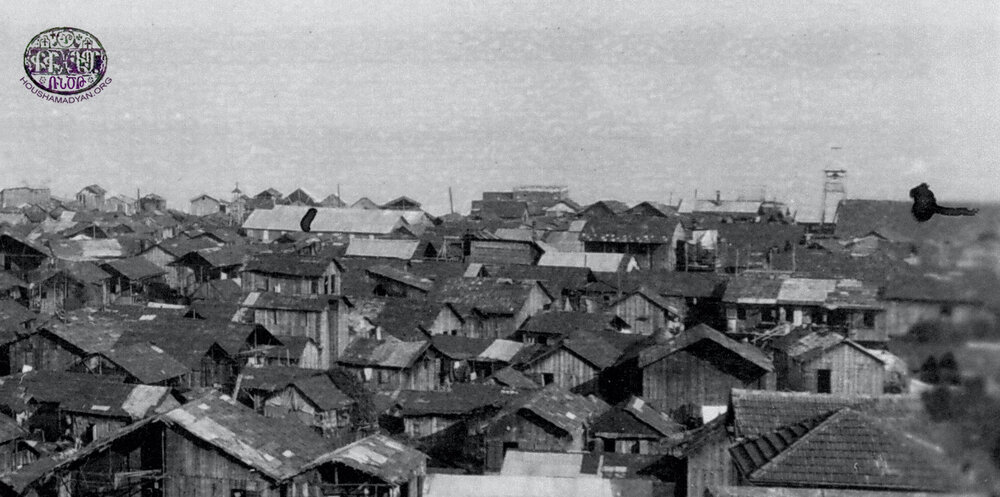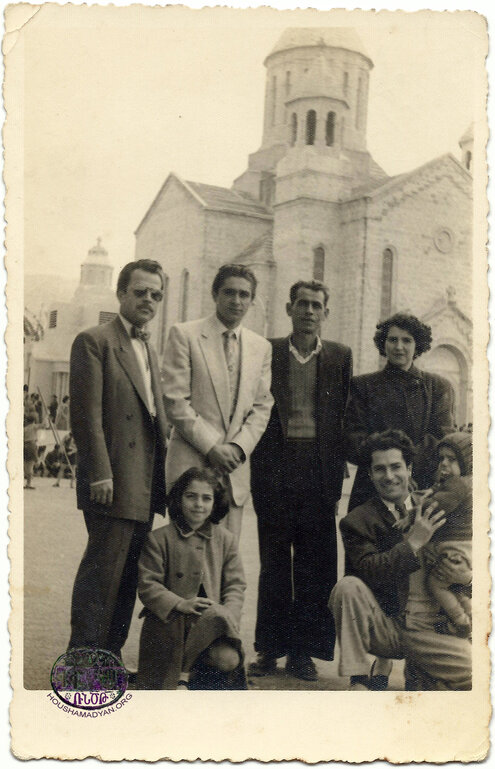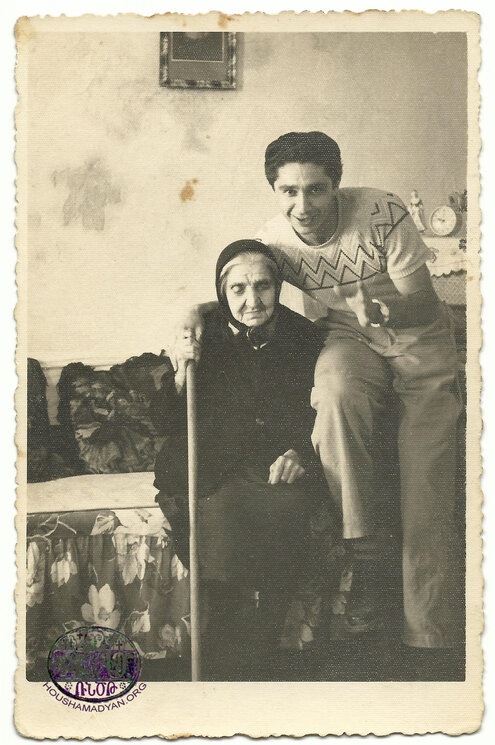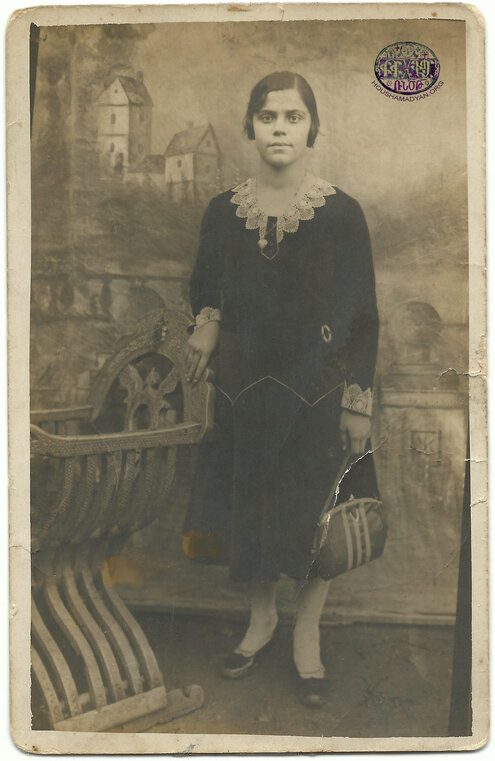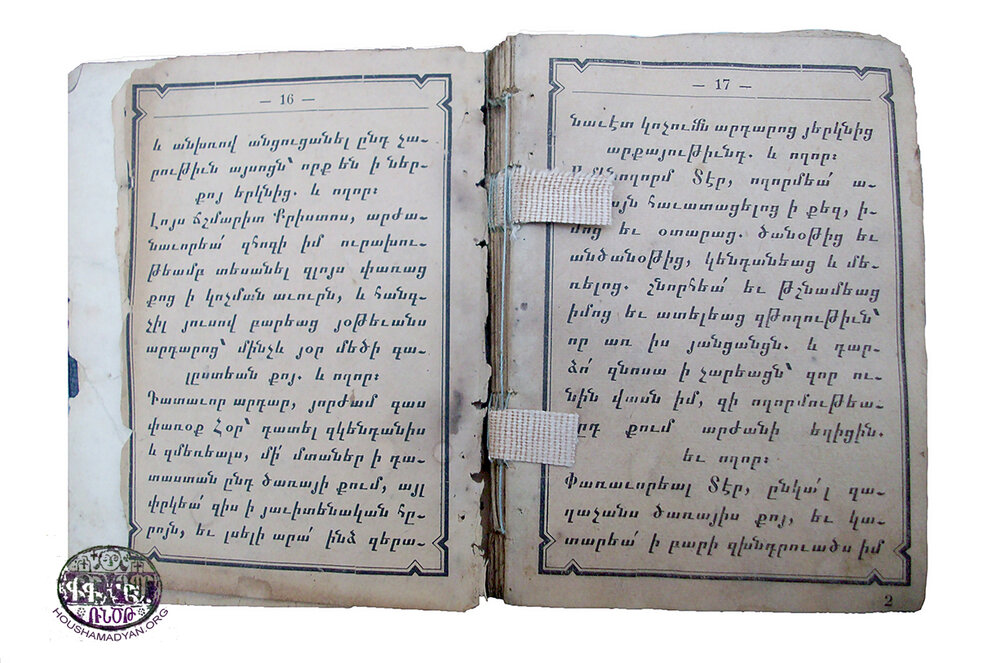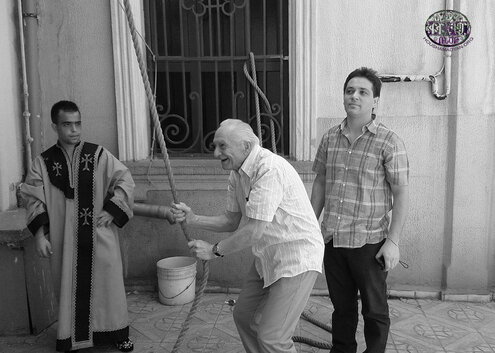Aslanian Collection - Buenos Aires

Author: Vahé Tachjian, 11/05/21 (Last modified 11/05/21), Translator: Hrant Gadarigian
The Aslanian family hails from Marash. There isn’t much information about the time the family lived there. We know that the Aslanian family traded in sheep and sold meat. Brothers Garabed, Hrant and Levon Aslanian were born in this family. Our story is mainly about Garabed Aslanian (later Father Hagop Aslanian) and his family.
Some members of the Aslanian family later adopted the surname Arslanian. Thus, in this article we will see the name spelled two ways.
1) & 3) Father Hagop Aslanian’s obituary. It was sent by the family to Buenos Aires, where Fr. Hagop’s sons Bedros and Peniamin lived. On the obit, in Armenian script Turkish is handwritten that the funeral was “like that of a Catholicos”. That’s to say the funeral was elaborate and well attended. On the back of the obit is a letter, dated March 22, 1940, written by Yeretsgin Khatoun, in Armenian-script Turkish, addressed to their children Bedros and Peniamin. The letter relates the conditions surrounding their father’s death.
2) Father Hagop Aslanian (1865-1940). Photo probably taken in Marash.
We know that Hrant Aslanian was an educated young man, presumably a graduate of the Jaranakavorats School of the monastery in Jerusalem. In 1895, he was arrested by the Ottoman authorities as a member of the Hunchak Party and was tortured to death in the Marash prison. It is said that Hrant was arrested due to the betrayal of an Armenian named Mgrdich.
There is more information about Garabed Aslanian. He was born in 1865 and attended Marash Central School. He was an acolyte at St. Stepanos Church. Garabed was ordained a priest in Zeytun by then Catholicos of Cilicia, Mgrdich Kefsizian (1871-1894), and was given the name Der Hagop. The newly ordained priest served for a short time in Zeytun, after which he returned to Marash and served in his native St. Stepanos Church.
In Marash, Der Hagop married Khatoun Saatdjian. The couple had five children - four sons, Smpad, Bedros, Peniamin and Hrant (Hadji) and a daughter, Marie (born 1914).
During the genocide, like the majority of Marash Armenians, the Aslanian family was deported along the Aleppo-Homs-Hama-Amman railway. We also know that Armenian clerics deported to these places were arrested in 1916 and sent in a separate group to Tafilah, a village south of Maan, near Jerusalem (now Jordan). Father Hagop, who was part of a group of exiled priests, managed to escape and find refuge in Jerusalem, where Catholicos Sahag II of Cilicia also lived in exile.

After World War I and the defeat of the Ottoman armies, survivors of the Aslanian family returned to their Marash hometown. These historic Cilicia areas were then occupied by the allied armies. A new life for Armenians began after the tragedy of the Genocide. But the new era did not last long. Turkish nationalist troops, following Mustafa Kemal Pasha (later Atatürk), besieged the city of Marash. The French-occupying armies gradually retreated and anti-Armenian massacres took place in the city. Twenty-two members of the Aslanian family were killed in the massacres. Father Hagop’s family then settled in Adana, which remained under French rule.
But their stay in Adana did not last long. France and Turkey signed an agreement in October 1921, according to which the French authorities would cede the entire territory of Cilicia to the new government in Ankara. This agreement generated panic among local Armenians who were emigrating en masse, especially to Syria and Lebanon.
Thus, Fr. Aslanian's family probably arrived in Beirut by boat from Mersin in the first weeks of 1922. Here, a large migrant camp was planned for the migrant population, northeast of Beirut, an area immediately near the port. To the north was the sea, and to the south was the tram line.


Life in a Beirut camp
The inhabitants of the Beirut camp were ordinary immigrants, Genocide survivors. Each had a unique history that, like every surviving Armenian begins in their native village and town. The road traversed by the camp refugees took them to Lebanon. Here, the saga continued, infused with numerous and various events, crises, losses, habits, languages, experiences, and cultures.
Just looking at a few photos of this Armenian refugee camp is enough to immediately convince the viewer that it lacked any minimum health requirements. The domiciles were huts built with assorted construction materials. The streets were muddy in winter and dusty in summer. Based on personal testimonies, the whole area suffered from an unbearable stench due to the lack of sewers. It was also overcrowded. People, families, existed side-by side, with little personal space. Lethargy reigned among camp residents. The exhaustion of being refugees, of surviving the Genocide, lead to depression and trauma. In other words, in such unnatural social conditions, the whole camp was vulnerable to disease and civil strife. Even murder was rampant․ Alcoholism was more than common. So too was gambling.
The camp environment would be the start of a new beginning for Father Hagop’s family, albeit in difficult and cramped conditions. Father Hagop’s wife and four of their children were here. Hadji (Hrant) was already married and had a family of his own. In 1924 or 1925, Father Hagop's brother Levon, with his family, also settled in the camp. They used to live in Damascus. Later, Levon's son, Hrant Arslanian, would write a biography of Fr. Hagop Aslanian (Recollections of the Faithful Life of Senior Priest Fr. Hagop Aslanian; 2010, Antelias) and publish it. Over the years, Aslanian family members managed to turn their camp hut into a two-story house.
Smpad, one of Father Hagop’s sons, is thought to have immigrated to the United States before or shortly after World War I. We know from family testimonies that he committed a crime in the early 1920's and that he remained locked up in a New York prison for decades. The motive for the crime was an argument over the girl he loved with another admirer. The problem had a deadly end.

Father Hagop continued his ministry among the Armenians of the Beirut camp. The construction of the wooden Holy Cross Church there owes much to the efforts of Father Hagop. The church was located in the Central Camp, also known as the Adana Camp, the Great Camp or the Mar Mkhayel Camp. This place was the first refugee camp where Armenians from Cilicia settled in Beirut. In this sense, Holy Cross was the first Armenian Apostolic Church in Lebanon, built by newly arrived Armenians. This whole refugee colony was sometimes referred to as Sourp Khach (Holy Cross). Not far from the Holy Cross Church, the Armenian Catholic and Armenian Evangelical churches also functioned in the camp.
The exact date of construction of the Holy Cross Church is not known. Its existence is mentioned in original sources starting from 1923. But it probably operated in more modest conditions from 1922 onwards. Initially, its roof was simply covered with canvas. The biography written about Father Hagop mentions that the priest personally went to the nearby Beirut market to buy the necessary canvas. We know that in 1923 the structure of this church underwent some improvement. The roof, as we see in the pictures, is covered with tin. The school functioned right next to the church since October 1923, and its name is noted as the "Sahagian" school since 1927. The camp also had a second Armenian Apostolic church, Holy Trinity, which was located in the refugee station called "Amanos". The school next to it was called "Mesrobian". In 1924, there were three priests in the whole camp.

Fighting, quarreling, and even murder were part of the daily life of the refugees. The Lebanese-Armenian, even the French and Arabic language press of the period, often referred to the camp's internal problems, especially when they were of a criminal nature.
The family story mentions an incident that also relates to the history of the Aslanian family. The date is not clear, but it is assumed that it took place in the 1920s or 1930s. The body of a murdered Armenian is found on the beach of the camp, whose identity will soon be revealed. It was the same Mgrdich who, as we saw in Marash, was known as a spy working for the Ottoman police. As a migrant, he was also forced to live in the close confines of the camp, where everyone knew each other. It was impossible to maintain one’s anonymity.
The name of Father Hagop Aslanian is also mentioned in relation to another incident that occurred in January 1926. At that time, the camp was a separate church diocese, the first primate of which was Father Yeprem Dohmouni. One night, a woman is seen in a room belonging to the primate. People gather and a ruckus is raised. The primate is attacked and beaten. The woman is taken out of the room and locked-up in another house. The next day, a large crowd consisting of opposing forces, those defending and accusing the primate, gathers in the Prelacy of the camp. This time, there is a bigger fight between the conflicting parties. There are shootings and stabbings. 7-8 people are injured. The Lebanese police intervene, and many are arrested. Articles are published in the press in which the Primate’s defenders accuse Father Hagop and another Marash resident, Avedis Aslanian (a relative of Fr. Hagop), of plotting the entire affair. They’re accused of secretly taking the woman to the Primate’s room to tempt the clergyman. Fr. Hagop supporters reject the accusation, claiming that the incident occurred without their involvement.
Such incidents could never have mitigated the miserable and brutal conditions of the camp. There were many who escaped this environment. One way to leave was to migrate to distant shores. The United States closed its borders to immigration, so France and South America (especially Argentina and Brazil) were the most popular destinations in those days. Bedros and Peniamin, Fr. Hagop’s sons, also emigrated to Argentina. In Bedros’ case, we know that this journey took place in 1928. He was accompanied by Bedros’ wife, Giulenia (née Koutoudjian), and sons, Antranig and Hovhannes/Juan. Antranig was born in 1927.
On January 30, 1933, a large fire broke out in the Adana camp, destroying some 600 houses and leaving 4,000 Armenians homeless. The Holy Cross Church and the Sahagian School also caught fire. During those years, new Armenian neighborhoods with stone houses began to be built in Bourj Hammoud, a suburb of Beirut. The main one was called Nor (New) Marash, where a large number of the camp people settled. Among them was the family of Father Hagop Aslanian.
Yeretsgin Khatoun Aslanian in her Bourj Hammoud home. Fr. Hagop’s portrait hangs on the wall.
There’s a short message, written on the back in Armenian-script Turkish, addressed to Bedros Arslanian. Evidently, Yeretsgin is unhappy for not receiving a letter from her son. She writes:
“My dear son Bedros Aslanian. Let this photo serve as a memento of me. You have forgotten me today. But when I die, I would like to say and be happy knowing that I raised a son. Nevertheless, be well. August 18, 1952.”
(Photo Edmond, Lebanon)

In Bourj Hammoud: A priest dear to the people and an amazing healer
Hrant Arslanian, a biographer of Fr. Hagop, writes that until the end, Fr. Hagop continued to maintain his camp home. Although he had a house of his own in Nor Marash, he also continued to live in the camp.
Father Hagop was dedicated to the prosperity of Nor Marash and to the work to build an Armenian church there. Numerous testimonies show that Fr. Hagop was a major motivating force in the construction of the St. Karasoun Manoug (Holy Forty-Martyrs) Church in Nor Marash. He organized fundraisers, gathered people around him and persuaded them to come and participate in the construction of the church. Some were common laborers, others skilled artisans, etc.
In 1931, when St. Karasoun Manoug was finished and opened its doors, Fr. Hagop became the chief priest of the church. But his spiritual work in this newly established Armenian district would not last long. In 1940, he suffered a stroke and died shortly afterwards on March 10 of the same year at his home in Nor Marash.
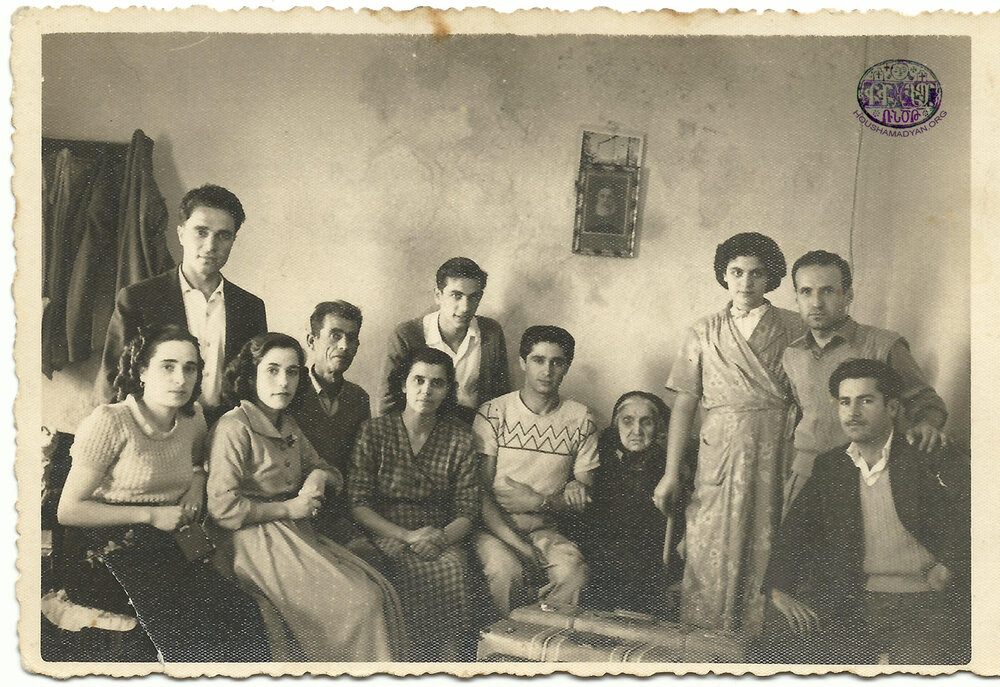

That day, his body was placed in St. Karasoun Manoug for public viewing. For a whole day, a throng of people marched past the body, laying in an open casket. The next day, a liturgy was celebrated, and the last consecration of the dead priest was performed with the participation of high-ranking clergy. In his sermon, Archbishop Yeghishe Garoyan, the Armenian Apostolic Primate of Lebanon, emphasizes that the camp’s Holy Cross Church and Nor Marash’ Holy Karasoun Manoug Church were built due to the efforts of Fr. Hagop. A huge procession, including students and teachers from Bourj Hammoud’s Apkarian, Aramian, Nubarian and Cilician schools, Homenetmen scouts, the clergy and well-wishers, marches through the districts of Nor Marash, before returning to Karasoun Manoug Church. Fr. Hagop is buried on the left side of the church, in a special grave prepared for the occasion.
I think that the fact that Fr. Hagop was so loved by the people was not only due to his devotion, modesty, honesty, and faith. The testimonies show that he had another reason to be honored by the people. Many believed in his miraculous healing power. He had this reputation since his priesthood days in Marash, but it gained ground among the exhausted and defenseless refugees of the camp and continued to do so in Bourj Hammoud.
Fr. Hagop’s "Gibrianos" (Cyprian) prayer book was famous in this sense. They believed that the prayers recited by the priest could heal the sick. In addition to the Armenian believers, the Turks in Marash also believed in his prayers. It is said that a woman who emigrated to the United States sent word to Fr. Hagop to donate a page from his "Cyprian" to cure her sick child. We know that many pages are missing from the priest’s "Gibrinaos". Surely others had approached the priest with the same wish. Some boiled the page in water and drank it.
We also know that after the death of Fr. Hagop people suffering from various diseases or their relatives would come and take a handful of soil from his tomb, put it in a coffee cup with water and drink it or give it to the patient to drink. In the days of refugee camp and Bourj Hammoud, local Muslims also came to Fr. Hagop and listened to his prayers in the hope of being healed.
Father Hagop’s ceremonial staff was as famous as the "Cyprian" prayer book. The clergyman did not hesitate to use this item to quell any manifestation of disorder. But there were people who considered these blows as a blessing…. It is said, for example, that a man came to Bourj Hammoud from the United States in the 1970s and, because of his extreme anxiety at a young age, his parents sought Fr. Hagop’s help. The priest's prayers were also in vain until he struck the boy with his staff. The believer is convinced that after this his anxiety ceased and the doors of success were open. Years later, the same man asked for a piece of Fr. Hagop’s wooden staff to put it under his son's pillow, expecting the same miracle.
During the immigration from Lebanon to Soviet Armenia in 1946-47, one of Der Hagop's sons, Hadji (Hrant), also took his family. Of Fr. Hagop's children, only Marie, who was married to Yervant Boyadjian, remained in Lebanon. Fr. Hagop’s wife, Khatoun also stayed in Lebanon.
In 1951, Smpad, who as noted, was imprisoned in the United States, was released and settled in Lebanon. He first lived with his sister, Marie, and then with his sister's daughter, Anahid, in Nor Marash, where he remained until his death. Smpad was 56 years old when he arrived in Lebanon, a country completely unknown to him.
Hadji's family would later emigrate from Armenia to the United States. Marie and her family were to leave Lebanon and settle in the United States.

Restoration of Father Hagop’s Memory
Over the past decade, especially given the convenience of social networking, the memory of Fr. Hagop has undergone a renewal among his descendants scattered around the world. Relatives from Argentina, France, the United States, and Abu Dhabi visit the tomb of Father Hagop in Bourj Hammoud, Lebanon. It’s a chance for strangers to get in touch with each other and sometimes even meet.
This experience is described to us by Garo Derounian, a Houshamadyan team member whose ancestors were from Marash, who has shown a special interest in the activities of Fr. Hagop and has often accompanied the relatives of the Marash priest during their various visits to Lebanon. Garo was the person who disseminated various writings, photos and stories about Fr. Hagop via the social networks, thus arousing the interest of many relatives and helping to restore the memory of the priest of Marash.
Among such visits to Lebanon, Garo mentions that of Lena Matossian-McCreary, the granddaughter of Marie (daughter of Fr. Jacob) and daughter of Anahid, from Abu Dhabi. This was followed by the visits of Antranig, the son of Bedros (who was son of Fr. Hagop) from Buenos Aires, and his grandchildren, as well as the visit of Hasmik Boyadjian Guillan, granddaughter of Marie. Antranig was one year old when he emigrated with his family to Argentina. As some of the images on this page show, he also visited Lebanon in 1953. His second visit took place in 2014, accompanied by his son Alejandro. Next, were the visits of Antranig’s wife Susana, with their daughters Marina and Veronica and son Marco.
Garo recounts the memorable meeting between Antranig and Bedros’s cousin, Hrant Arslanian. As noted, Hrant was the author of Fr. Hagop’s biography. Antranig passed in 2019, and Hrant in 2020. It is noteworthy that the common language of the two relatives was Turkish, so their entire conversation takes place in that language. Turkish was the spoken language of Fr. Hagop, as well as of many Armenian families in Marash. In the late 1920s, when Antranig's father, Bedros, left the camp with his family, the majority language there was also Turkish. In fact, Bedros took this linguistic heritage with him to Buenos Aires and continued to speak Turkish in the family. In the same way Antranig also grew up learning and speaking this language. The various family cards and letters presented on this page are also written in Turkish with Armenian letters. For example, when Hadji immigrated to Armenia, some of his writings to family members were in Turkish with Armenian letters.
Finally, I would like to mention that most of the materials published on this page are digital images or documents kept by Garo Derounian. Susana Alaez Arslanian (Antranig's wife) has the originals in Buenos Aires.
Sources:
- Armenian-language newspapers published in Lebanon and Egypt - Lipanan, Arev, Piunig.
- Deacon Hrant Arslanian: Recollections of the Faithful Life of Senior Priest Fr. Hagop Aslanian; 2010, Antelias.








